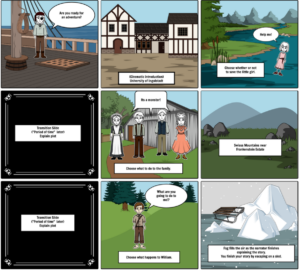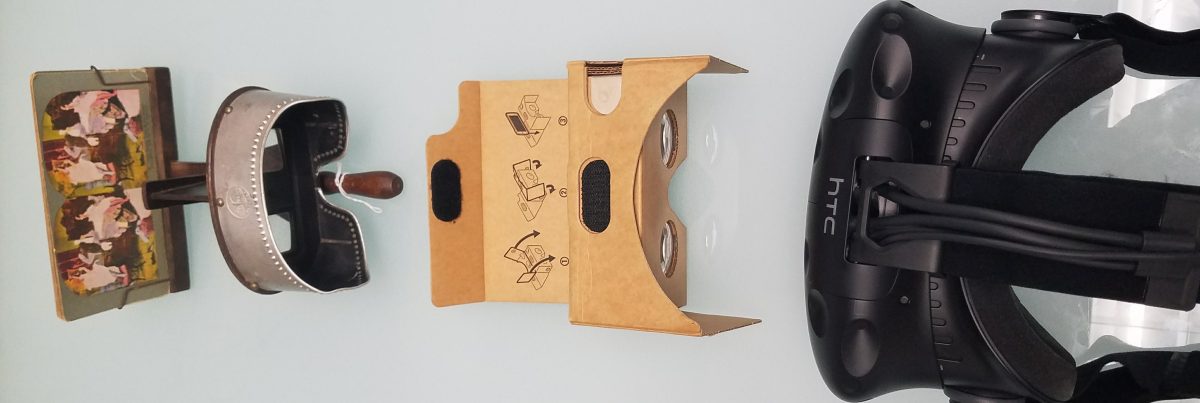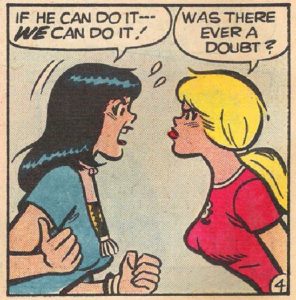Frankenstein VR:
Introduction:
Frankenstein VR is a Virtual Reality app developed specifically for the Google Cardboard system. This is an interactive game modeled after the classic children’s game-book series “Choose-Your-Own-Adventure” popularized in the 1980’s and 1990’s (Chooseco LLC 2018). This app utilizes the user’s autonomous choices to teach concepts of empathy through the guise of Mary Shelley’s Frankenstein. Players experience the events that unfold in quintessential Mary Shelley’s Gothic novel through the eyes of the Creature, thus literally placing them “in the monster’s shoes”.
Mary Shelley’s Frankenstein is a relatively ubiquitous piece of literature across most of Western society. If one has not read it, they are at least familiar with the grotesque image of the green-skinned ghoul with bolts in his neck propagated by early Hollywood. Due to the story’s renown, Frankenstein VR in turn will be popular across two major demographics. The primary audience and main target market for the Frankenstein VR app is students aged 14-20 who are concurrently studying the original text. It is meant to be an educational tool that informs and reinforces the main conflicts the Creature comes across in the novel. In turn, the app brings the larger concept of empathy for the “Others” in society to the forefront of the student’s mind, allowing for an in depth discussion to be facilitated by their professors. The secondary audience for the Frankenstein VR app is the general public with access to a smartphone and Google Cardboard. The purchase of the VR app through the consumer’s preferred App store, will drive revenue, and allow for the further development of an interactive game app that can be experienced without the use of the Google Cardboard. While Frankenstein VR will give the users a unique and thought provoking experience, no matter their age, the primary function is to ultimately instill a better understanding of the importance of empathy via practical application.
Victor Frankenstein’s Creature is an embodiment of the inherent empathy gap that has been ever prevalent in the world. The Creature is regarded as a societal “other”, and thus rebuked from the 19th century world in which he resides, and while we regard the morals of the world 200 years ago as perhaps less evolved, the same prejudices exist under different guises in the 21st century. In fact, a 2010 test designed by the University of Michigan to measure the prevalence of empathy across a wide swath of age gaps reported back a startling figure; “College Students today are 40 percent less empathetic than those who graduated two or three decades ago” (Gasgreen 2010). The main fault in our modern thinking is that the “concept of persona is linked towards a problematic attitude towards human life, derived from theology” (Carpi 2011). This is exemplified in the Creature’s personal struggle and self-identification with the figure of Lucifer in Milton’s Paradise Lost (Shelley 1813). There have always been those who fit into the societal “norm”, and the “others” who do not, but with the invention of the internet, there has been a spike in our overall awareness of those who have been “othered”. Those who do not conform to the glorified image of humans made in the image of an all powerful, perfect God can no longer be shunned and forgotten like in centuries past, and we are forced to confront the fact that our current perception of who is deemed worthy of our empathy is based heavily on their own, predestined physicality. Personhood is thus “characterized by two contrasting modes: it tends to be individual, but also needs to be put in relation with the ‘other’” (Carpi 2011). With the 24 hour media exposure we have become accustomed to, it is important that the upcoming generation of young adults grow, or at least maintain the level of empathy already instilled within them. With this in consideration, another 21st century phenomenon, Virtual Reality, is the perfect avenue to teach empathy. The engaging nature of the game is the key to teaching empathy as “it is unrealistic to expect students to become more empathetic if they aren’t actually committed to the idea” (Gasgreen 2010). Through the avenue of the Frankenstein narrative, the mindset of our youth can be changed, which is especially important because “the educated young people are the people who are going to be changing policies in the future (so), we better be sure they’re empathetic” (Gasgreen 2010).
Learning Outcomes:
The objective of Frankenstein VR game is to enhance empathy in users through directly experiencing and understanding the hardships the Frankenstein Monster had to endure in Mary Shelley’s novel. In this Virtual Reality (VR) game, users are put in the shoes of Frankenstein’s monster, without the player initially knowing that is who they are. Users will interact with characters from the novel who are either in dire help or in fear of the Monster (you, the user). Users will then have varying choices during these interactions. By the end of the experience, the more empathetic choices users make the more empathy points they’ll have scored. Teachers will have access to the scores of each user and will be able to determine their class’s overall empathy percentage.
One common question that people have about educational games, such as this one, is why does it have to be through a VR simulation? Studies investigated by researchers at Stanford University concluded that, “VR perspective-taking tasks may be more effective at improving attitudes towards specific social targets and motivating prosocial behaviors in the form of signed petitions in support of helpful initiatives than traditional and less immersive perspective-taking tasks.” (Herrera, 33). The studies done at Stanford Univ. were specifically geared towards the homeless. Users were put into VR and other less-immersive simulations of a homeless person and then all the data was compared. Of all the tests and simulations, VR was the only simulation that actually inspired users to sign petitions to go out and actually help the homeless.
“Putting on a VR headset… is an act of surrendering the self for the sake of another.” (‘C.T. Casberg’, Granados, 10-11). In this VR game, we aren’t seeking petitions from our users, we rather seek the effectiveness a VR simulation can have in enhancing empathy. “The intensity of VR immersion seems like a natural tool for sparking empathy. It lets you see, hear and, to a limited extent, even feel the same things as its central subject, in some cases allowing users to wander through a world at their own pace.” (Granados, 10). This is exactly what we’ll allow users to have: several different choices in situations that require users to think carefully about their decisions, but they can travel through at their own pace. By the end, certain decisions will give users a score that rates their empathy. Teachers can then gather the data to tally an overall class empathy percentage and begin discussion questions about the simulation to further understand the importance of empathy when it comes to socialization with people they have never met.
User Experience and Interface:
There are other games that have a choice based system put in place, but most of them are not specifically based in Virtual Reality. Detroit: Become Human for example has multiple choice routes, but does not have a VR interface and is restricted to console only. There is a Frankenstein VR game called Frankenstein: Beyond the Time, however, it does not focus on teaching empathy. Instead, it accomplishes something entirely different from our VR app. Frankenstein: Beyond the Time is an open world scavenger hunt game allows the user to explore a virtual world by looking for human body parts to put into a pot in order to assemble Frankenstein’s monster. In contrast, we are focusing on a Frankenstein choice-based adventure game that will teach empathy.
Our game will be accessed via a smartphone app designed for the Google Cardboard due to its affordability and ease of use. Some of the main advantages of using the Google Cardboard are increased mobility and accessibility. It is also more realistic to use in a classroom than other bulkier devices. The Pew Research Institute stated that about 90% of students aged 14 – 20 have cell phones (Pew Research Center 2018). If a student doesn’t have a cell phone then they can borrow a friend’s phone. This is why using Google Cardboards is more convenient and efficient within the age group. Students will be using the Google Cardboard to implement their choices in each of the empathy response inducing situations. By using the white dot in the center, students can move their heads toward the corresponding choice that they want to make, and select it with a button on the side of the device. Within our app, students will watch an interactive choice-based video and different scenes will unfold based on their choices.
Implementation Strategy:
Frankenstein VR is being designed with a focus on affordability and accessibility. The Google Cardboard is the clear option in the affordable VR realm. Not only is it one of the least expensive VR devices on the market, it also has a built in magnet that acts as a button, which fulfills our need for the player to be able to make choices. That being said, there are also many affordable options for external controllers. The simplicity of our game’s mechanics will allow it to be playable on all systems that use a controller for years to come.
In order to reach the public and complete our primary mission, teaching empathy, we will be bring Frankenstein VR to the top educational conferences in the nation. Many of these conferences have international representation as well. This is where thousands of educators go to research and test out new teaching methods, trends, and products. We will offer playable demos of Frankenstein VR at these conferences to the very teachers and professors that will implement it into their classrooms. Offering them a first hand experience will prove to be the best way to reach them. We will also have promotional videos that we will post on social media. Our product will be in high demand in the future based on the fact that “the global virtual reality market in the education sector will grow at a CAGR of over 59% during the forecast period. The increasing need for experiential learning is a major factor driving the market’s growth” (Technavio 2018). Simply put, there is a growing demand for products like ours.
Long Term Vision:
Frankenstein VR has two distinct phases of development to optimize the efficacy of promoting the discussion of empathy. Phase One consists of the development of the VR app for the Google Cardboard Device. Our VR prototype will be a limited release to teachers only, and will be part of a demo packet for the Google Cardboard marketed towards educators. Once feedback has been gathered about the first experiences on the app, it will be debugged/adapted if necessary, and then given to the mass market on Steam, the Google Play store, or the Apple App Store.
After the popularity of the VR app is garnered, Phase Two will be set into motion and, a smartphone app with further plot points from not only Frankenstein, but other popular Gothic novels in the public domain such as Bram Stoker’s Dracula, The Strange Case of Dr. Jekyll and Mr. Hyde, The Castle of Otranto, and many others will be developed. The app will be updated monthly with new chapters of the stories, and in app purchases will be available. This allows the company to bring on a host of popular digital artists and further their popularity amongst the general online public. The empathy scale will be carried throughout each experience and your empathy score will be cumulative. Following the successful launch of the VR and iPhone apps, we will focus on branding, diversifying art styles within the app, and keeping them consistent with each story, and moving into the convention circuit. We will also look into creation of physical merchandise such as art prints. With the growing market demand for Virtual Reality experiences Frankenstein VR is a prime product and lucrative business venture.
Works Cited:
Beach, Jason1, jbeach@tntech.ed., and Jeremy1, jwendt@tntech.ed. Wendt. “Using Virtual Reality to Help Students with Social Interaction Skills.” Journal of the International Association of Special Education, vol. 16, no. 1, Mar. 2016, pp. 26–33. EBSCOhost, cdcdccezproxy.stevenson.edu/login?url=https://search.ebscohost.com/login.aspx?direct =true&db=eue&AN=121404514&site=eds-live&scope=site.
Carpi, Daniela. Bioethics and Biolaw Through Literature. De Gruyter, 2011. EBSCOhost, ezproxy.stevenson.edu/login?url=https://search.ebscohost.com/login.aspx?direct=true&db=e000xna&AN=407462&site=ehost-live.
“Demographics of Mobile Device Ownership and Adoption in the United States.” Pew Research Center: Internet, Science & Tech, Pew Research Center: Internet, Science & Tech, 5 Feb. 2018, www.pewinternet.org/fact-sheet/mobile/.
Gasgreen, Allie. “Empathizing 101.” Inside Higher Ed, Inside Higher Ed, 24 Nov. 2010, www.insidehighered.com/news/2010/11/24/empathizing-101.
Granados, Luis. “Virtual Reality and Empathy.” Humanist, vol. 78, no. 2, Mar. 2018, pp. 10–11. EBSCOhost, ezproxy.stevenson.edu/login?url=https://search.ebscohost.com/login.aspx?direct=true&db=a9h&AN=128114427&site=ehost-live.
Herrera, Fernanda, et al. “Building Long-Term Empathy: A Large-Scale Comparison of Traditional and Virtual Reality Perspective-Taking.” PLoS ONE, vol. 13, no. 10, Oct. 2018, pp. 1–37. EBSCOhost, doi:10.1371/journal.pone.0204494.https://ezproxy.stevenson.edu/login?url=https://search.ebscohost.com/login.aspx?direct=true&db=a9h&AN=132436483&site=ehost-live
“History of CYOA.” Chooseco LLC, 2018, www.cyoa.com/pages/history-of-cyoa.
Technavio. “Global Virtual Reality Market in Education Sector – Social VR Spaces on the Rise | Technavio.”Business Wire, 23 Feb. 2018, www.businesswire.com/news/home/20180223005844/en/Global-Virtual-Reality-Market-Education-Sector–

Link to Slideshow Presentation: https://docs.google.com/presentation/d/1iwCoonoRoq-hwPWFJPyVaHt0VWsVng3S-rYfh6_7BgM/edit?usp=sharing

